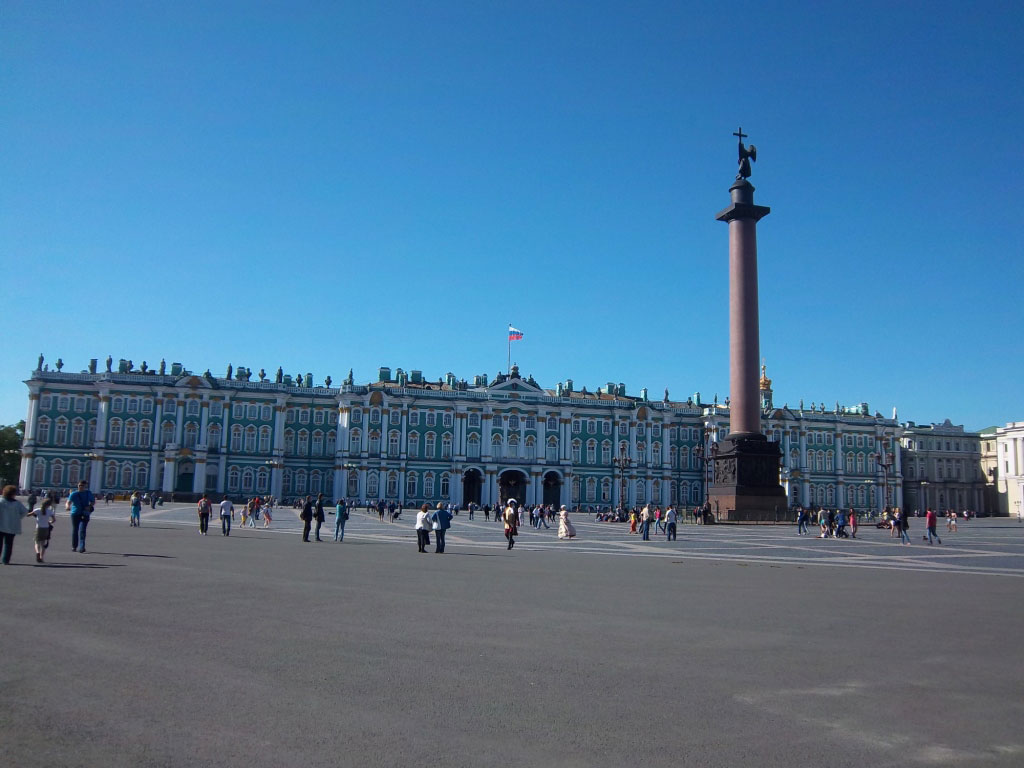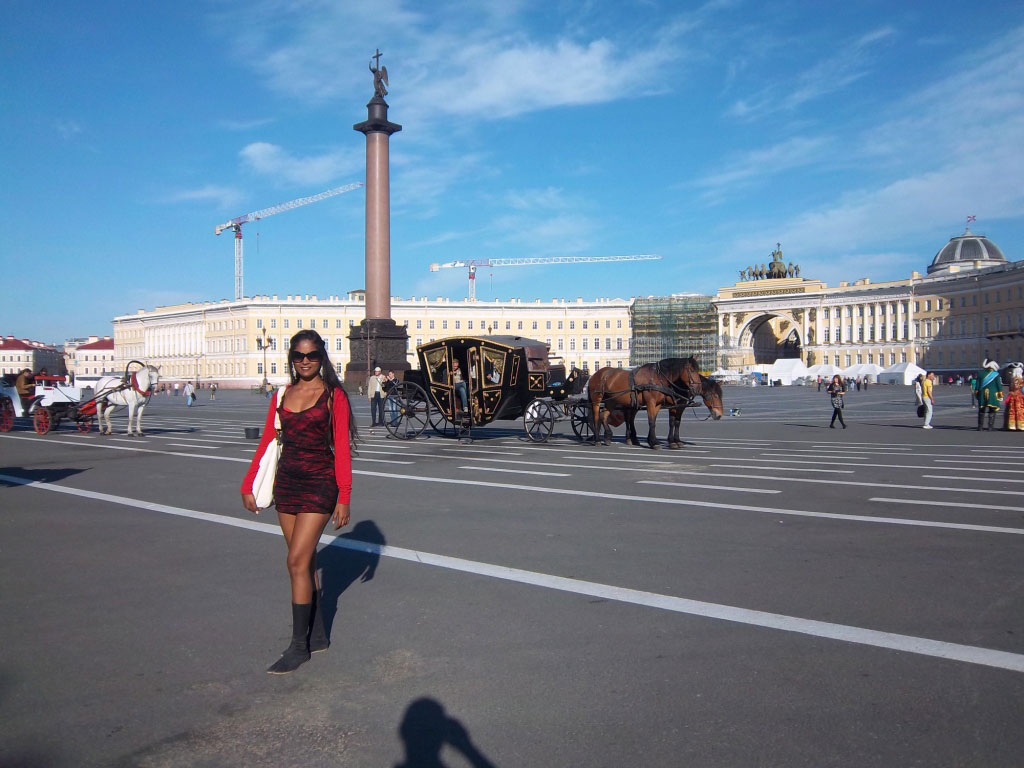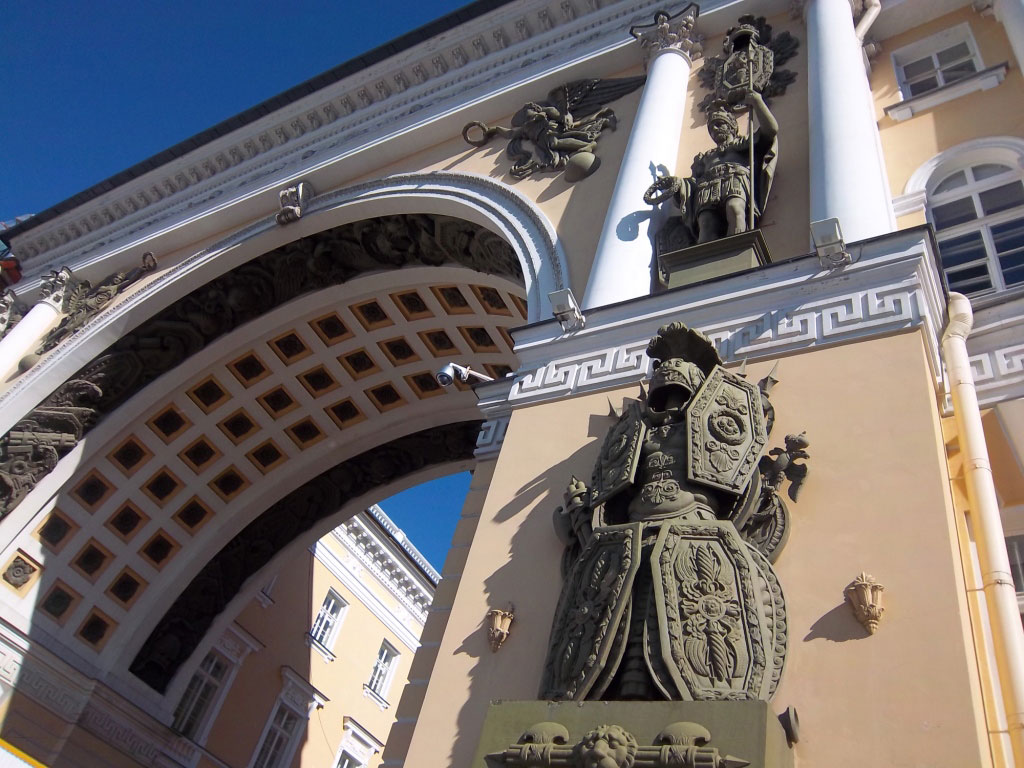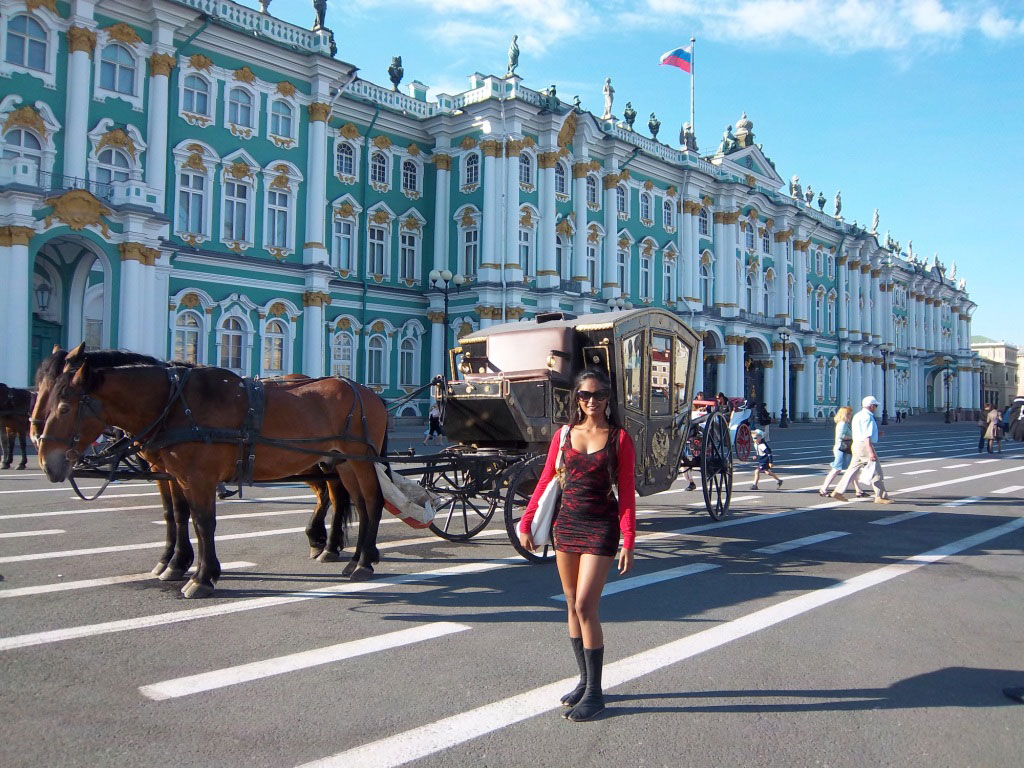| For communicating - Alexander: | |
| +7 (985) 690-95-16 (engl, rus) | |
| sashamaharaja | |
| For communicating - Alexander: | |
| +7 (985) 690-95-16 (engl, rus) | |
| sashamaharaja | |
The pleasure boat brought us back to the pier of the Griboyedov Canal near the Church of the Saviour on Blood. We walked along the quay, turned right, and continued driving along Nevsky Prospect. Soon, from the opposite side, a street of fabulous beauty — Bolshaya Morskaya — beckoned us.
At the end of Bolshaya Morskaya, a majestic arch is located. It was created by an Italian architect, Carlo Rossi, in honour of the victory of Russia in the war with the French Emperor — Napoleon. This arch is decorated with knightly armour and sculptures of warriors. The arch is located in the centre of the General Headquarters of the army built in the shape of a horseshoe.

Just beyond the arch, the Palace Square opened to our eyes. For two centuries, it was the main square of the Russian Empire. Seeing the square, I was delighted. Palace Square in Saint Petersburg is about two times larger than Red Square in Moscow. In the centre of the Palace Square there is a huge column crowned with an angel sculpture with a cross. On the opposite side, the brilliant Winter Palace, which we just watched from the Neva river just an hour ago, once again appeared before us.
Everything in Palace Square is created in strict and perfect harmony. Like the Winter Palace, Palace Square was created according to the plan of a brilliant Italian architect — Francesco Rastrelli, whose design formed the basis for the creation of the square. Another great Italian master — Carlo Rossi, the author of the General Headquarters and the Arc de Triomphe, continued the ideas of the genius.
For many hours in Saint Petersburg, I have not met a single Indian. I had the feeling of a discoverer, as if I was the first Indian woman to set foot on the land of Saint Petersburg. In fact, this was certainly not the case. Later, I learned a curious fact. It turns out that Indian culture was clearly present in Saint Petersburg in the middle of the 18th century.
In the summer of 1766, the famous Saint Petersburg Tournament (which was notable for its special luxury, fantasy, and scope) took place on Palace Square. Its participants were divided into four quadrilles: Roman, Slavic, Turkish, and Indian. Each group had corresponding outfits, weapons, special chariots, and even various musical instruments.

Even then a large group of participants of the festival was in Indian costumes and with Indian musical instruments. I was struck by the fact that already at that time Petersburgers were familiar with Indian culture, which was present at their festivities along with Western European and Slavic cultures.
However, most of all my attention was focused on a giant column in the centre of Palace Square. This column is called Alexander, in honour of Alexander I of Russia. It was also built in honour of the victory of Russia over the army of Napoleon in the war of 1812. The Alexander Column was designed by a French architect Auguste de Montferrand. The column was installed 20 years after the victory over Napoleon; the grand opening took place in 1834.
Looking at the column, I did not understand how people in those days could manage to create and plant such a grand scale, when there were no cars, no excavators or tower cranes?! That’s a dissonance in my head. I wanted to know everything in detail.
I learned that the Alexander Column is the tallest monument in the world, which is made of solid granite. Together with the pedestal and crowning sculpture, the height of the monument is 48 meters. The barrel of the column is the tallest and heaviest monolith ever installed as a column or obelisk vertically. This only inflamed my desire to learn more information about the creation of the column.
The figure of an angel with a cross on a column was created by Russian sculptor Boris Orlovsky. From below, the figure of the angel seems quite small, whereas in reality its height is 6.4 meters, that is, the size of a decent two-storey house. The angel with the cross symbolizes the protection and patronage of Saint Petersburg.

The column and the angel sculpture mounted on it do not have any additional rods and props; they hold only under the influence of their own weight. The slightest earthquake could have destroyed the Alexander Column; however, there have never been such natural disasters in Saint Petersburg. In the first years after the installation of the column, many townspeople bypassed and drove around it fearing its fall. Every evening the architect Montferrand walked the dog near the column by personal example demonstrating the reliability of his own creation to the citizens.
The total weight of the Alexander Column together with the pedestal is more than 1000 tons. Sure, I was very interested to find out how people created and installed such a giant structure in the centre of Saint Petersburg.
The column and pedestal were carved out of granite rock located in the territory of modern Finland. Ship engineer Konstantin Glazyrin designed and built a special barge with a carrying capacity of 1,100 tons. To carry out loading work, jetty and quay-pier were built.
The process of building the column lasted for five years. To bring the column into a vertical position, they involved 2,400 soldiers and workers. On the opening day of the Alexander Column, a huge hundred-thousandth army marched on Palace Square; it was the largest parade of the era.
In the era of Communism, only a miracle saved the Alexander Column from alteration. The Communists were annoyed by an angel at the top of the column; each time during solemn events, it was covered with various materials and devices. In the minds of the party leaders, there were plans to replace the angel with a statue of Lenin or Stalin. Fortunately, the plans of the vandals could not be realized.

Against all the odds, the Alexander Column survived during the Second World War. The column and the angel are so high that Petersburgers failed to figure out how to completely cover them under disguise. The angel remained undisguised under the fire of enemy shells and bombs.
As it turned out after the war, the angel was injured: one of its wings was damaged by a shell fragment. Nevertheless, the angel survived, as did the whole Alexander Column, all of Saint Petersburg, and all of Russia.
At the beginning of the 21st century, restorers discovered that the Alexander Column was in a deplorable state, since cracks appeared at its top and it was in danger of destruction. For several years, restoration work, which eventually allowed preserving this unique structure, was carried out.
I learned all this later. At that moment, I was lost for words looking at the wonder of the world — the Alexander Column and Palace Square.
Sasha had his memories associated with this place. Three years earlier, he was at Palace Square at a concert of his favourite singer, former leader of Pink Floyd — Roger Waters. Sasha was here after a tantric seminar with another woman from another “before-Goa” life. And now he was standing on Palace Square with a new wife from India. He had something to remember and something to think about.
Your request / application / question
Enter your name, question and email.
Our manager will contact you promptly and answer all your questions.
Request a callback
Enter your phone number and our manager will contact you promptly.